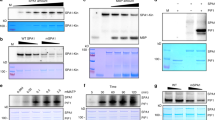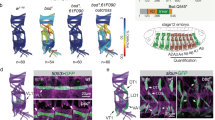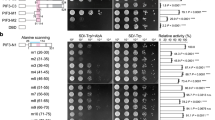Abstract
Many of the proteins that are critical for Drosophila phototransduction assemble into a signaling complex, signalplex, through association with the PDZ-domain protein INAD. Some of these proteins depend on INAD for proper subcellular localization to the phototransducing organelle, the rhabdomere, making it difficult to assess any physiological function of this signaling complex independent of localization. Here we demonstrated that INAD bound directly to the NINAC myosin III, yet the subcellular localization of NINAC was normal in inaD mutants. Nevertheless, the INAD binding site was sufficient to target a heterologous protein to the rhabdomeres. Disruption of the NINAC/INAD interaction delayed termination of the photoreceptor response. Thus one role of this signaling complex is in rapid deactivation of the photoresponse.
This is a preview of subscription content, access via your institution
Access options
Subscribe to this journal
Receive 12 print issues and online access
$209.00 per year
only $17.42 per issue
Buy this article
- Purchase on Springer Link
- Instant access to full article PDF
Prices may be subject to local taxes which are calculated during checkout






Similar content being viewed by others
References
Ranganathan, R., Harris, G. L., Stevens, C. F. & Zuker, C. S. A Drosophila mutant defective in extracellular calcium-dependent photoreceptor deactivation and desensitization. Nature 354, 230–232 (1991).
Hardie, R. C. Whole-cell recordings of the light induced current in dissociated Drosophila photoreceptors: evidence for feedback by calcium permeating the light-sensitive channels. Proc. R. Soc. Lond. B 245, 203 –210 (1991).
Scott, K. & Zuker, C. Lights out: deactivation of the phototransduction cascade. Trends Biochem. Sci. 350– 354 (1997).
Porter, J. A., Yu, M., Doberstein, S. K., Pollard, T. S. & Montell, C. Dependence of calmodulin localization in the retina on the ninaC unconventional myosin. Science 262, 1038–1042 ( 1993).
Porter, J. A., Minke, B. & Montell, C. Calmodulin binding to Drosophila NINAC required for termination of phototransduction. EMBO J. 18, 4450–4459 (1995).
Montell, C. & Rubin, G. M. The Drosophila ninaC locus encodes two photoreceptor cell specific proteins with domains homologous to protein kinases and the myosin heavy chain head. Cell 52, 757–772 (1988).
Porter, J. A., Hicks, J. L., Williams, D. S. & Montell, C. Differential localizations of and requirements for the two Drosophila ninaC kinase/myosins in photoreceptor cells. J. Cell Biol. 116, 683–693 ( 1992).
Scott, K. & Zuker, C. TRP, TRPL and trouble in photoreceptor cells. Curr. Opin. Neurobiol. 8, 383– 388 (1998).
Montell, C. TRP trapped in fly signaling web. Curr. Opin. Neurobiol. 8, 389–397 (1998).
Montell, C. & Rubin, G. M. Molecular characterization of the Drosophila trp locus: a putative integral membrane protein required for phototransduction. Neuron 2, 1313– 1323 (1989).
Dolph, P. J. et al. Arrestin function in inactivation of G protein-coupled receptor rhodopsin in vivo. Science 260, 1910– 1916 (1993).
Chevesich, J., Kreuz, A. J. & Montell, C. Requirement for the PDZ domain protein, INAD, for localization of the TRP store-operated channel to a signaling complex. Neuron 18, 95–105 ( 1997).
Tsunoda, S. et al. A multivalent PDZ-domain protein assembles signalling complexes in a G-protein-coupled cascade. Nature 388, 243–249 (1997).
Arikawa, K., Hicks, J. L. & Williams, D. S. Identification of actin filaments in the rhabdomeral microvilli of Drosophila photoreceptors. J. Cell Biol. 110, 1993–1998 (1990).
Huber, A. et al. The transient receptor potential protein (Trp), a putative store-operated Ca2+ channel essential for phosphoinositide-mediated photoreception, forms a signaling complex with NorpA, InaC and InaD. EMBO J. 15, 7036–7045 (1996).
Xu, X.-Z. S., Choudhury, A., Li, X. & Montell, C. Coordination of an array of signaling proteins through homo- and heteromeric interactions between PDZ domains and target proteins. J. Cell Biol. 142, 545–555 (1998).
Shieh, B.-H. & Zhu, M.-Y. Regulation of the TRP Ca2+ channel by INAD in Drosophila photoreceptors. Neuron 16, 991–998 (1996).
Adamski, F. M., Zhu, M.-Y., Bahiraei, F. & Shieh, B.-H. Interaction of eye protein kinase C and INAD in Drosophila: localization of binding domains and electrophysiological characterization of a loss of association in transgenic flies. J. Biol. Chem. 273, 17713–17719 (1998).
O'Brien, R. J., Lau, L.-F. & Huganir, R. L. Molecular mechanisms of glutamate receptor clustering at excitatory synapses. Curr. Opin. Neurobiol. 8, 364–369 (1998).
Colledge, M. & Froehner, S. C. Signals mediating ion channel clustering at the neuromuscular junction. Curr. Opin. Neurobiol. 8, 357–363 ( 1998).
van Huizen, R. et al. Two distantly positioned PDZ domains mediate multivalent INAD-phospholipase C interactions essential for G protein-coupled signaling. EMBO J 17, 2285–2297 ( 1998).
Shieh, B. H., Zhu, M. Y., Lee, J. K., Kelly, I. M. & Bahiraei, F. Association of INAD with NORPA is essential for controlled activation and deactivation of Drosophila phototransduction in vivo . Proc. Natl. Acad. Sci. USA 94, 12682 –12687 (1997).
Porter, J. A. & Montell, C. Distinct roles of the Drosophila ninaC kinase and myosin domains revealed by systematic mutagenesis. J. Cell Biol. 122, 601–612 (1993).
Fields, S. & Song, O. A novel genetic system to detect protein-protein interactions. Nature 340, 245– 246 (1989).
Songyang, Z. et al. Recognition of unique carboxyl-terminal motifs by distinct PDZ domains. Science 275, 73– 77 (1997).
Stricker, N. L. et al. PDZ domain of neuronal nitric oxide synthase recognizes novel C-terminal peptide sequences. Nat. Biotech. 15, 336–342 (1997).
Lee, Y.-J. et al. The Drosophila dgq gene encodes a Gα protein that mediates phototransduction. Neuron 13, 1143–1157 (1994).
Shieh, B.-H. & Niemeyer, B. A novel protein encoded by the InaD gene regulates recovery of visual transduction in Drosophila. Neuron 14, 201–210 ( 1995).
Pak, W. L. in Genetic Approaches to the Nervous System (ed. Breakfield, X. O.) 67–99 (Elsevier, New York, 1979).
Niethammer, M., Kim, E. & Sheng, M. Interaction between the C terminus of NMDA receptor subunits and multiple members of the PSD-95 family of membrane associated guanylate kinases. J. Neurosci. 16, 2157–2163 (1996).
Sprengel, R. et al. Importance of the intracellular domain of NR2 subunits for NMDA receptor function In vivo. Cell 92, 279–289 (1998).
Williams, D. S. Actin filaments and photoreceptor membrane turnover. Bioessays 13, 171–178 ( 1991).
Hicks, J. L., Liu, X. & Williams, D. S. Role of the ninaC proteins in photoreceptor cell structure: ultrastructure of ninaC deletion mutants and binding to actin filaments. Cell. Motil. Cytoskeleton 35, 367– 379 (1996).
Gillespie, P. G. & Corey, D. P. Myosin and adaptation by hair cells. Neuron 19, 955– 958 (1997).
Hasson, T. et al. Unconventional myosins in inner-ear sensory epithelia. J. Cell Biol. 137, 1287–1307 (1997).
Mismer, D. & Rubin, G. M. Analysis of the promoter of the ninaE opsin gene in Drosophila melanogaster. Genetics 116, 565–578 (1987).
Patton, J. S., Gomes, X. V. & Geyer, P. K. Position-independent germline transformation in Drosophila using a cuticle pigmentation gene as a selectable marker. Nucleic Acids Res. 20, 5859–5860 (1992).
Spradling, A. C. & Rubin, G. M. Transposition of cloned P elements into Drosophila germline chromosomes. Science 218, 341–347 ( 1982).
Rubin, G. M. & Spradling, A. C. Genetic transformation of Drosophila with transposable element vectors. Science 218, 348–353 (1982).
Acknowledgements
We thank W.L. Pak and L.L.R. Strong for instruction in the intracellular recordings, D.R. Hyde for antibodies to Gqα, C.S. Zuker for inaD1 flies, K.M.C. Sullivan for critiquing the manuscript and S. Morgan for technical assistance. P.D.W. was a HHMI Predoctoral Fellow. This investigation was supported by a grant from the National Eye Institute to C.M. (EY08117).
Author information
Authors and Affiliations
Rights and permissions
About this article
Cite this article
Wes, P., Xu, XZ., Li, HS. et al. Termination of phototransduction requires binding of the NINAC myosin III and the PDZ protein INAD. Nat Neurosci 2, 447–453 (1999). https://doi.org/10.1038/8116
Received:
Accepted:
Issue Date:
DOI: https://doi.org/10.1038/8116
This article is cited by
-
In vivo identification of Drosophila rhodopsin interaction partners by biotin proximity labeling
Scientific Reports (2024)
-
Dietary restriction and the transcription factor clock delay eye aging to extend lifespan in Drosophila Melanogaster
Nature Communications (2022)
-
Phototransduction in Drosophila
Science China Life Sciences (2012)



